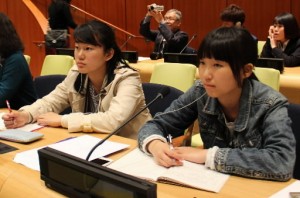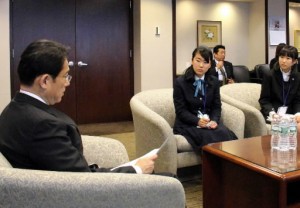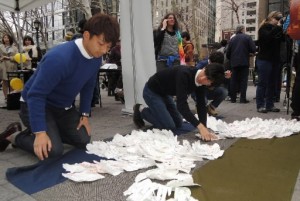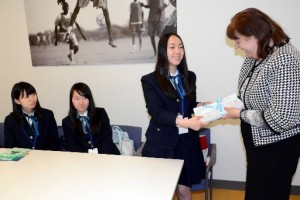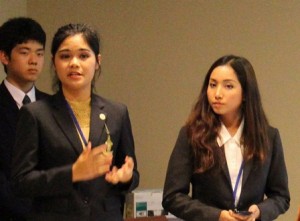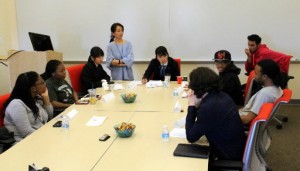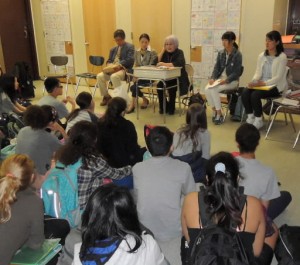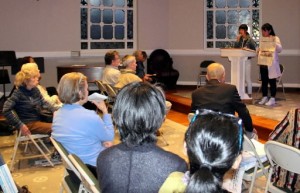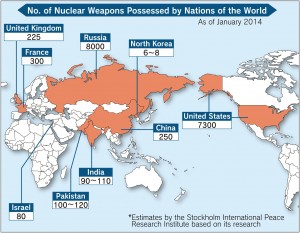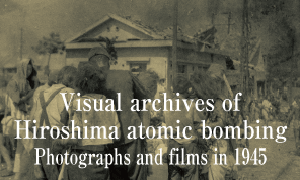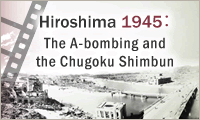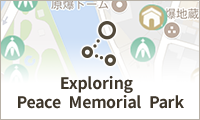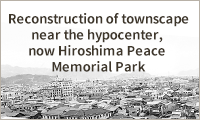Peace Seeds: Teens in Hiroshima Sow Seeds of Peace (Part 9)
May 27, 2015
Part 9: Junior writers cover NPT review conference: Future without nuclear weapons not a dream
by Junior Writers Shiori Niitani, 16, and Nozomi Mizoue, 15
The review conference for the Nuclear Non-proliferation Treaty (NPT) is being held from April 27 through May 22 at United Nations headquarters in New York. The conference, whose purpose is to check on the functioning of the NPT, is held once every five years. As junior writers for the Chugoku Shimbun, we went to New York during the first week of the conference and covered speeches on nuclear disarmament by government representatives and non-governmental organizations (NGO) from various nations. We also exchanged views with local junior high school and college students.
We had an opportunity to get a first-hand look at international politics, including an occasion when the United States and Russia criticized each other. Meanwhile we were encouraged by the strong statements by NGO representatives in favor of the abolition of nuclear weapons. We also realized the high expectations for the young generation to continue to tell the story of the atomic bombing of Hiroshima. We would like to see the nations that are parties to the NPT actively work to put together an agreement on nuclear abolition, which is the hope of the A-bomb survivors, while they are still alive.
Fellow seekers of peace around the world
■Report on our activities
NGO session: impact of civil society sensed
The session for non-governmental organizations (NGO), an official event of the NPT review conference, opened with a video message from the International Campaign to Abolish Nuclear Weapons (ICAN). The organization, whose membership includes more than 400 groups in 95 countries, is working toward the establishment of a nuclear weapons convention. Citing the advancement of women and the treaty banning land mines, ICAN said that it is important for civil society to consider the inhumanity and illegality of nuclear weapons.
The mayors of Hiroshima and Nagasaki gave speeches during the session, which lasted three hours. Afterwards atomic bomb survivors and lawyers representing 16 groups called for the elimination of nuclear weapons from various points of view. Ban All Nukes generation (BANg), an international NGO made up of young people, likened the current nuclear weapon situation to someone falling from a tall building. While the person may be all right now, eventually the worst will happen when the person hits the ground. BANg shed light on that sense of danger, which gave us a start. We were reminded that as long as nuclear weapons exist, they may be used.
Terumi Tanaka, then 13, was about 3.2 km from the hypocenter at the time of the atomic bombing of Nagasaki. He described the deaths of five relatives and closed his remarks by saying: “It is unacceptable to possess nuclear weapons in the name of security. Nuclear weapons were made by people and must be eliminated by people.”
Many people, including representatives of the governments of various countries, listened closely to Mr. Tanaka and he received a big round of applause. We realized that NGOs are having an even greater impact on the international community than we had imagined.
Interview with Foreign Minister Kishida: frank views heard
Employees of the Foreign Ministry were present for our interview with Fumio Kishida, Japan’s foreign minister, so the atmosphere was a little tense at first. But Mr. Kishida listened attentively as we spoke, and we were able to talk with him calmly.
When we asked Mr. Kishida what young people could do to eliminate nuclear weapons, he said, “I have high expectations. I’d like you to continue to convey [the message of nuclear abolition] to the world.” It was unfortunate, however, that he was reading from a paper while talking to us.
But when we followed up by asking him if our message was being heard by governments and the United Nations, he replied kindly, saying: “The people of many countries have been moved.” We were glad to get a frank reply from him.
The foreign minister also said, “Japan must be the catalyst for a shared awareness of the inhumanity of nuclear weapons by the countries that possess them and those that do not.” A catalyst is something that, while remaining unchanged itself, causes a chemical reaction. We felt that this truly described the current situation in which Japan has taken very little specific action, although it offers proposals to the U.N.
Speech by Foreign Minister Kishida: What about Japan’s own policy?
On April 27, the day the NPT review conference began, we listened to a speech by Foreign Minister Kishida during the general debate. He called on world leaders to visit Hiroshima and Nagasaki and asked for their cooperation. But he did not seem to lay out any specific plan for action by Japan.
In order for Japan to take the lead as the only country to have experienced atomic bombings, we feel that Japan must not only express its determination but also announce specific measures that it will take.
During the general debate, including during Mr. Kishida’s speech, many people went in and out of the hall, and about 40 percent of the seats were empty. We wondered whether the representatives of the various governments were really focused on the meeting.
■Young people
Nagasaki Youth Delegation: shape of dove holds hopes for nuclear abolition
Twelve members of the Nagasaki Youth Delegation and two supporters came to New York. The delegation, which was formed two years ago with the support of Nagasaki Prefecture, the City of Nagasaki and Nagasaki University, sends young people to international conferences on nuclear disarmament. In addition to sitting in on the NPT review conference, delegation members held discussions with diplomats and representatives of NGOs from various countries at which they called for the elimination of nuclear weapons.
The day before the start of the review conference, the delegation and other peace-related organizations set up a booth in a plaza next to U.N. headquarters, where they carried out their Peace Dove Project. Visitors to the booth made an outline of one of their hands and then wrote or drew a message of peace on it. Representing the wing of a dove, a symbol of peace, the outlines were then attached to a piece of cloth to form the shape of a dove. The group’s goal was to get 500 wings.
We saw one message that said in Japanese: “True peace begins with individual actions.” We hope that, as the message said, small actions lead to the first step toward the elimination of nuclear weapons.
Soichiro Hide, 20, a sophomore at Nagasaki University who is head of the PDP, said, “By participating in this project, I would like people to realize that nuclear issues affect them personally and to have a greater awareness of peace.” He said the delegation had also visited a local Japanese school and gotten its students to write messages for the PDP. They had also gathered messages from students at Nagasaki University before leaving for the U.S.
The dove, which measured 2.5 meters by 4 meters when it was completed, was displayed at U.N. headquarters on May 7 when the Nagasaki Youth Delegation held an event there. The delegation planned to give a briefing on its activities in Nagasaki after returning home.
Hiroshima high school students take petitions, give presentations in English
A total of ten students from Hiroshima Jogakuin High School (Naka Ward, Hiroshima) Shudo High School (Naka Ward, Hiroshima), Eishin High School (Fukuyama, Hiroshima Prefecture), and Okinawa Shogaku High School (Naha) were sent to the review conference by the Hiroshima Peace Culture Foundation. All of the students are participants in The Abolition of Nuclear Weapons Signature Campaign by Students of Hiroshima and Okinawa.
On April 29 the ten students gave the petitions they had gathered over the last year, which included about 44,000 signatures, to Virginia Gamba, Director and Deputy to the High Representative for Disarmament Affairs of the U.N. Office for Disarmament Affairs. Tomohiko Sakamato, 17, of Eishin High School said, “As someone who has heard the accounts of A-bomb survivors, when she heard that we would pass on their stories of the miseries of war and the atomic bombings, she was sympathetic to our effort.”
At the Mayors for Peace Youth Forum, which was held at U.N. headquarters on April 30, each school gave a presentation in English using slides. The students talked about how they had become interested in peace through the petition drive and described their other activities, such as taking students from other schools to the Cenotaph for the A-bomb Victims and other monuments in Hiroshima’s Peace Memorial Park. The forum participants held a wide-ranging discussion that covered issues such as the Holocaust, Japan’s wartime aggression, and the U.S. military bases in Okinawa.
In the afternoon the students went to Stuyvesant High School in New York City, where they gave a presentation on the atomic bombing and exchanged views with students there.
College students from Thailand stress need for international network
Nada Waeyusoh, 22, and Fahrudee Songluck, 21, college students from Thailand, are members of the Bangkok Youth Council, an official body of the City of Bangkok. Its members represent the young adults and children residing in the city and work toward a “peaceful and sustainable society.”
At the Mayors for Peace Youth Forum, which we also attended, the two students from Thailand gave a slide show in which they talked about the youth council’s structure and its three pillars: knowledge, action and publicity. They also outlined their normal activities and said they wanted to create a peaceful society by broadening the international network of young people.
The world faces many problems, including issues related to education and the environment. The students from Thailand pointed out that peace is the best strategy for solving these problems. They also said that by considering society’s problems when they are young, once they become adults, people come to believe that solving problems through dialogue is important.
We realized that we are not the only young people who want to share with many others what we as young people can do. This gave us an even greater awareness of the importance of our peace-related activities.
■Meetings with local students
Meeting with American college students reveals differences in thinking
We met with six students (from freshmen to seniors) at the State University of New York College at Old Westbury, which is located about 35 km east from New York City. We had heard that the students had no particular interest in the issue of nuclear weapons, but amid a friendly atmosphere, we considered the issue seriously and exchanged views.
The U.S. is a major nuclear power. When we asked the students if they would like to see nuclear weapons eliminated, they offered various opinions. One said that it would be scary if other countries had nuclear weapons but the U.S. did not. Another said the government needed to have them in order to make the country appear strong. Another said that because the method of their manufacture is known, even if nuclear weapons were eliminated someone would make them again. We were exposed to the belief that, practically speaking, nuclear weapons cannot be eliminated, a notion that is perhaps to be expected of citizens of a nuclear power.
But one senior, Robert Wright, 22, said that it is governments, not individuals, who want nuclear weapons and that people should get together to resist this desire on the part of governments. When we heard that, we were encouraged, thinking that nuclear abolition is not impossible.
With regard to the atomic bombings of Hiroshima and Nagasaki, one student said that the U.S. needed to drop an atomic bomb somewhere in order to test it and that China might have been A-bombed if Japan had not. We had not heard that view before and were surprised.
Visits to junior high school, church: peace activities start with dispelling mistrust
We visited the New York City Lab School for Collaborative Studies along with Hisako Kimura, 78, an atomic bomb survivor and resident of Sendai, Miyagi Prefecture. Ms. Kimura was 8 years old and in Osuga-cho (now part of Hiroshima’s Minami Ward), about 1.6 km from the hypocenter, at the time of the atomic bombing. When she showed a picture of maggots crawling on her grandfather, who also survived the atomic bombing, some of the seventh graders grimaced or covered their eyes or mouths. There was an air of tension, and we could tell that the students were thinking about the A-bombing seriously.
One girl asked if Ms. Kimura hated the U.S., which made us stop and think. She said, “I used to hate America, but I don’t any more. That’s why I have come to the U.S. and am sharing the story of Hiroshima and Nagasaki with you.” When she said that, the girl who had asked the question and many other students looked relieved. Of course, the atomic bombings by the U.S. were inhumane and unacceptable. But peace activities begin with ridding ourselves of feelings of hatred and dispelling our distrust. We realized that this is also essential in our activities as junior writers and in everyday life.
Afterwards we went to a church in the town of Briarcliff Manor, about 50 km north of New York City, along with two atomic bomb survivors: Toshiyuki Mimaki, 73, of Kita Hiroshima-cho, and Sumiko Nakamura, 81, of Mihara, Hiroshima Prefecture. Unlike at the junior high school, many of those present were elderly, and we were a little nervous at the thought of talking with them about the A-bombing.
But when the survivors described their A-bombing experiences and we talked about our activities as junior writers, members of the audience said that the A-bombing was wrong or that it was not necessary. We felt ashamed at having had a preconceived notion of older Americans. In terms of our desire for nuclear abolition, the differences in our nationalities or ages made no difference.
The following are paraphrased comments by students at the New York City Lab School based on Japanese translations of the original English.
I felt I must take an interest in nuclear weapons. I would like to learn more. (Justine Zhen, 12)
When I heard the A-bomb survivor’s story, I felt something like that must never happen again. I think if people read more books and articles on nuclear weapons and understand the issue better, nuclear weapons will be abolished. (Daphne Raskin, 12)
I got a better understanding of what the U.S. did to Japan. Learning is important. There is only one earth, so it’s important for countries to take action together and to understand each other. (Anna Creed, 12)
I’m glad I was able to hear the story of an A-bomb survivor directly. I understood her suffering and sadness. It’s not good to kill innocent people. Hearing about what the junior writers are doing, I thought it was interesting that young people are telling others about peace. I think that’s important. I’d like to tell others about it. (Meera Nemali, 12)
I realized for the first time what a big thing happened and how people’s happy lives were destroyed. I’d like to tell other people about that. (Elisabeth Escudero, 12)
By hearing the A-bomb survivor’s story directly, I was able to learn the truth and understand her feelings. As I listened, I thought about photos of the A-bombing that I had seen. More people should listen to the stories of the A-bomb survivors, and nuclear weapons should be banned. (Martina Visus, 13)
Hiroshima Prefecture’s panel discussion at U.N. headquarters: lots of advice on nuclear abolition
Six representatives of the United Nations, governments, the City of Hiroshima and non-governmental organizations shared their opinions in a panel discussion held by Hiroshima Prefecture at United Nations headquarters.
Ambassador Alexander Kmentt, Director of Disarmament, Arms Control and Non-Proliferation for Austria’s Ministry of Europe Integration and Foreign Affairs, stressed the need for people to visit Hiroshima and Nagasaki, saying they could get a new sense of morality that could only be acquired there. He also stated that the nuclear weapons situation must be changed right away.
Kazumi Matsui, mayor of Hiroshima, said, “Looking ahead to the next generation, we must consider nuclear weapons, which can decimate ordinary citizens.” As young people who were born and raised in Hiroshima and are involved in peace activities, we were encouraged by the remarks by these two men.
After the comments by the panelists, we noted that the survivors of the atomic bombings of Hiroshima and Nagasaki as well as young people have worked hard for peace yet nuclear weapons have not yet been abolished and asked what should be done. In reply, Angela Kane, High Representative for Disarmament Affairs of UN office for Disarmament Affairs, said that the citizens of nations that are not members of the NPT and countries that do not participate in disarmament negotiations must exert more pressure on their governments. This gave us new insight.
We also found an answer to a question that arose when we interviewed Foreign Minister Fumio Kishida: Is it possible for Japan, which is under the nuclear umbrella of the U.S., to move forward with the abolition of nuclear weapons? John Burroughs of the International Association of Lawyers against Nuclear Weapons suggested specific policies. He said that it was important for Japan to conclude a treaty creating a nuclear-free zone in northeast Asia, to make efforts to restore friendly relations with other Asian countries, and to create an environment in which it will not need to be under the nuclear umbrella.
Presentation at Mayors for Peace Youth Forum outlines activities of junior writers
We participated in the Mayors for Peace Youth Forum, which was held at United Nations headquarters, and gave a presentation in English on the activities of the junior writers. We were nervous, but there was a friendly atmosphere in the hall, where many members of the audience were atomic bomb survivors or members of the news media.
Our presentation, which included slides, lasted about 10 minutes. We noted that 114 employees of the Chugoku Shimbun were killed in the atomic bombing and gave an overview of the paper’s peace coverage, described “Peace Seeds” and its peace-related articles, and talked about our interviews with A-bomb survivors and other activities of junior writers and conveyed our thoughts on peace.
Our slide show featured photos of junior writers preparing articles, a video of an interview with an A-bomb survivor, and articles that have been printed in the newspaper. In closing, we showed a video of 14 junior writers smiling and waving and inviting everyone to come to Hiroshima. At one point there was a problem with the sound and we were a little frantic, but the audience patiently waited for the problem to be fixed.
We got a round of applause at the end of our presentation, and we felt a sense of accomplishment in having gotten our ideas across. One A-bomb survivor from Nagasaki expressed pleasure that the atomic bombing experience had been passed on to young people, and we were relieved when we heard that.
■Reflections on our trip
Sentiments of A-bomb survivors still not getting across
by Shiori Niitani
I made my first trip to the United States wondering what the country that dropped the atomic bomb on my hometown was like. The people I met there were truly kind. Though our skin and eye colors may have been different, the warmth I felt when we shook hands was the same. It pained me to think that 70 years ago the people of our two nations were killing each other.
The U.S. and Russia were criticizing each other at U.N. headquarters. Although it should have been a meeting at which everyone was working toward nuclear disarmament and non-proliferation, I saw conflicts between nations and sensed the difficulty of building trust between nations. At the session for non-governmental organizations, young people from South Korea asked why Japan didn’t denounce the U.S. for dropping the atomic bombs. I felt it was unfortunate that the feelings of the atomic bomb survivors were not getting across to people; they no longer hate the U.S. and believe that the tragedy of the atomic bombings must not be repeated. We must continue to convey the message of the A-bomb survivors to the world.
While talking with Americans, I heard many negative comments about nuclear weapons such as that the atomic bomb should not have been dropped no matter what, that nuclear weapons must be abolished, or that people cannot live life in safety as long as nuclear weapons exist. Their feelings were the same as ours. I was convinced that we could build a peaceful world.
Yoshifumi Okamura, Ambassador Extraordinary and Plenipotentiary, DPR Special Representative for TICAD, told me that in order to persuade nuclear nations to give up their weapons, you must first find out why they have them and then be able to rebut that view. We must not only convey the horrors of the atomic bombings but also listen to what the other person has to say. I would like to learn more about nuclear-related issues from various points of view and convey what I’ve learned to others.
Believing in the power of young people, we will spread the word
by Nozomi Mizoue
While feeling certain that nuclear weapons were an absolute evil and must be eliminated, as a junior writer I sometimes wondered whether the world would be inspired to take action based on the urging of ordinary citizens like us.
But now, having covered and reported on the NPT review conference, I believe that the abolition of nuclear weapons is possible. And I am convinced that the power of civil society is essential in order to achieve that goal.
That is because, in addition to seeing a lot of NGOs that are working energetically for peace, I had a chance to talk with local college students. They had little knowledge of the atomic bombings or nuclear weapons. But we all shared the belief that nuclear weapons should be abolished, which is the hope of most of the young people of the world. On an individual level, no one needs nuclear weapons. The future will be built by young people like us. Most young people desire nuclear abolition. I believe that a future such as that will be even better than the present.
Getting a close look at the world taking action at U.N. headquarters, I was reminded that political action is conducted by people. In other words, it was people who manufactured nuclear weapons and people who started wars. So, if civil society continues to call for the elimination of nuclear weapons, people will be inspired, and that is very important.
We will tell people about the atomic bombings of Hiroshima and Nagasaki. Doing so will no doubt lead to a better future.
Keywords
Nuclear Non-proliferation Treaty
The Nuclear Non-proliferation Treaty, the only international treaty on nuclear disarmament, came into effect in 1970 during the Cold War and was ratified by Japan in 1976. Today 190 nations are parties to the treaty, which limits the possession of nuclear weapons to the United States, Russia, the United Kingdom, France and China. Three of the four de facto nuclear powers – India, Pakistan and Israel – are not members of the treaty. North Korea declared its withdrawal from the treaty in 2003. Depending on the international situation at the time of the review conference, a final document is not always adopted.
What is Peace Seeds?
The goal of Peace Seeds is to consider peace and the value of human life from a variety of perspectives and spread these values around the world to bring smiles to people’s faces. The 49 junior writers of the Chugoku Shimbun, who range from sixth graders to high school seniors, come up with their own ideas, conduct their own interviews and write their own articles.
Acknowledgment
by Rie Nii, Staff Writer in charge of junior writers
Through the efforts of Japan’s U.N. Information Center, a special exception was made for the two junior writers, and they were able to get press passes to cover the NPT review conference at U.N. headquarters. The discussions with people at New York City Lab School for Collaborative Studies, Scarborough Presbyterian Church in Briarcliff Manor and the State University of New York College at Old Westbury were made possible through the assistance of the Japan Confederation of A- and H-Bomb Sufferers Organizations, the Japanese Consumers’ Co-operative Union, and Ryoko Yamamoto, an assistant professor at the college. Copies of the English translation of a picture book called “Hiroshima: A Tragedy Never To Be Repeated” were given to both the Lab School and the public library in Briarcliff Manor, where the church is located, as gifts from Ties with the World, a volunteer group that distributes picture books on the atomic bombing and peace around the world. We would like to express our sincere gratitude to all those with Hiroshima Prefecture and Mayors for Peace who made it possible for us to cover the NPT review conference.
(Originally published on May 14, 2015)

